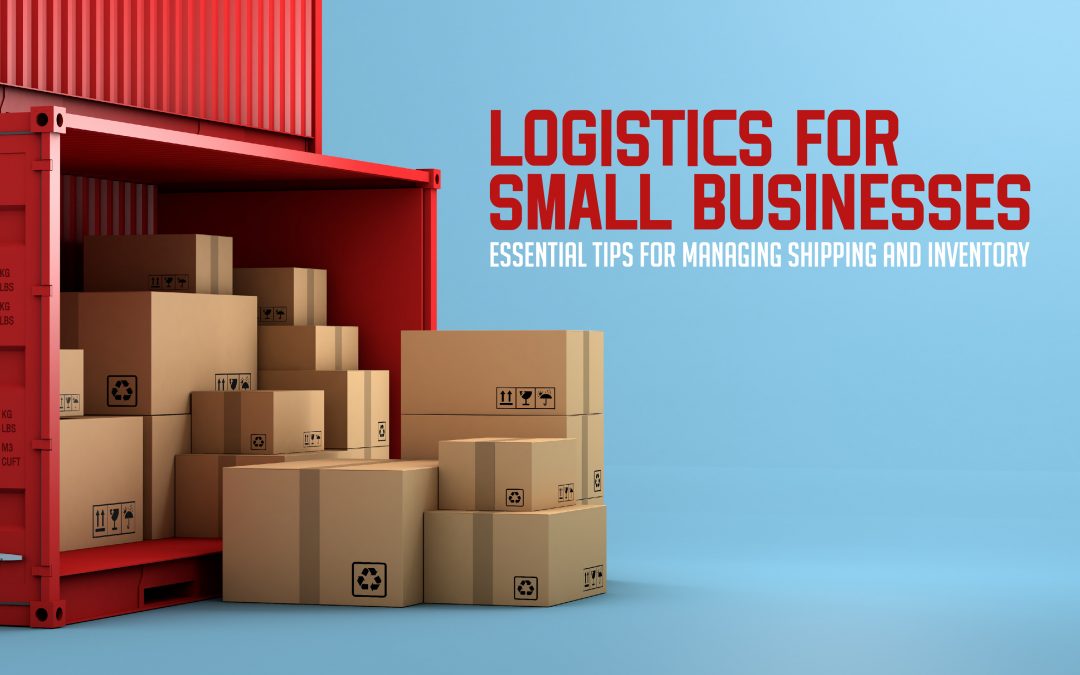Efficient logistics are crucial for the success of small businesses, impacting everything from customer satisfaction to operational costs. Effective shipping and inventory management can streamline operations and enhance overall performance. By leveraging modern technology and implementing best practices, you can optimize your logistics processes. Here’s a comprehensive guide with actionable tips to help you manage shipping and inventory effectively:
1. Develop a Robust Inventory Management System
A well-organized inventory management system is essential to avoid overstocking or stockouts, which can lead to lost sales or increased carrying costs. Implementing inventory management software that provides real-time updates on stock levels, sales, and orders will help you track inventory more accurately and make informed restocking decisions.
Tips:
- Use Barcode Scanning: Automate data entry with barcode scanning to reduce errors and speed up inventory processes.
- Implement Reorder Points: Set reorder points to automatically trigger stock replenishment when levels fall below a certain threshold.
- Leverage Cloud-Based Solutions: Cloud-based systems offer real-time access and collaboration, enhancing decision-making.
- Integrate with E-Commerce Platforms: Sync orders and inventory levels automatically with your e-commerce platform to maintain accurate stock data.
2. Optimize Your Shipping Strategy
Shipping is a key factor in customer satisfaction and can significantly affect your bottom line. Evaluate different shipping carriers and options to balance cost and delivery time effectively. Negotiating rates with carriers as your volume grows can also lead to better deals.
Tips:
- Offer Multiple Shipping Options: Provide various shipping choices, such as standard, expedited, and same-day delivery, to cater to different customer needs and budgets.
- Utilize Shipping Software: Automate label printing, tracking, and returns with shipping software to enhance efficiency and accuracy.
- Use Shipping Rate Comparison Tools: Compare shipping rates across multiple carriers to find the most cost-effective option.
- Implement Shipping Automation: Streamline processes with software that automates tracking and updates.
3. Implement Efficient Warehouse Management
An organized warehouse is crucial for fast and accurate order fulfillment. Design your warehouse layout to optimize space and streamline picking and packing processes. Employ warehouse management systems (WMS) to manage inventory locations, order picking, and shipping tasks.
Tips:
- Arrange Products Strategically: Place high-demand items in easily accessible locations to speed up picking and packing.
- Conduct Regular Audits: Regularly audit inventory to ensure accuracy and identify discrepancies or inefficiencies.
- Adopt Automated Picking Systems: Use robotic pickers or conveyor belts to enhance the speed and accuracy of order fulfillment.
- Implement RFID Technology: Utilize RFID tags and scanners for better inventory tracking and reduced manual errors.
4. Focus on Packaging
Packaging plays a critical role in protecting your products during transit and enhancing the customer experience. Invest in high-quality packaging materials that safeguard products and reflect your brand’s image.
Tips:
- Choose the Right Size: Use appropriately sized packaging to minimize shipping costs and reduce the risk of product damage.
- Consider Sustainability: Opt for eco-friendly packaging materials to appeal to environmentally-conscious customers and reduce your environmental impact.
- Utilize Smart Packaging: Incorporate sensors and QR codes for real-time data on product conditions during transit.
- Enhance Branding: Design packaging that highlights your brand and improves the unboxing experience for customers.
5. Track and Analyze Performance
Regularly monitoring and analyzing logistics performance helps identify areas for improvement. Track key metrics such as shipping times, inventory turnover rates, and order accuracy to assess your logistics efficiency.
Tips:
- Use Analytics Tools: Employ tools that offer insights into logistics operations and enable data-driven decisions.
- Gather Customer Feedback: Collect and analyze customer feedback on shipping experiences to pinpoint areas for service enhancement.
- Monitor Key Performance Indicators (KPIs): Track KPIs like order accuracy and shipping costs to evaluate and refine logistics strategies.
- Implement Predictive Analytics: Utilize predictive analytics for forecasting demand and optimizing inventory levels.
6. Build Strong Relationships with Suppliers and Carriers
Strong relationships with suppliers and shipping carriers can lead to better service, improved communication, and more favorable terms. Maintain open communication and work collaboratively to resolve issues.
Tips:
- Negotiate Terms: Discuss payment terms, lead times, and delivery schedules with suppliers and carriers to align with your business needs.
- Evaluate Performance: Regularly assess the performance of suppliers and carriers to ensure they meet your standards.
- Use Supplier Portals: Leverage supplier portals for real-time updates on orders and inventory.
- Leverage Carrier Integration: Integrate with carrier systems for real-time shipment tracking and updates.
7. Stay Compliant with Regulations
Ensure your logistics operations comply with relevant regulations, including shipping restrictions, customs requirements, and safety standards. Familiarize yourself with industry-specific and location-based regulations.
Tips:
- Monitor Regulatory Changes: Stay updated on regulatory changes that may impact your logistics operations and adjust processes accordingly.
- Automate Compliance Documentation: Use software to automate the generation and management of compliance documents.
- Train Your Team: Educate your team on regulatory compliance and best practices to ensure adherence to standards.
8. Embrace Technological Advancements
Technological innovations continue to transform logistics for small businesses. Embracing these advancements can simplify processes and enhance efficiency.
Tips:
- Explore AI and Machine Learning: Use AI and machine learning to optimize inventory forecasting, route planning, and demand prediction.
- Adopt IoT Solutions: Implement IoT devices for real-time tracking and monitoring of shipments to improve visibility and security.
- Invest in Automation: Incorporate automation technologies to streamline various logistics processes and reduce manual tasks.
Conclusion
Efficient logistics management is key to the success of small businesses. By leveraging modern technology and implementing best practices, you can optimize shipping and inventory management, reduce costs, and enhance customer satisfaction. Implementing a robust inventory management system, optimizing shipping strategies, focusing on packaging, and embracing technological advancements will help streamline your logistics operations and position your business for growth and success in a competitive market.













